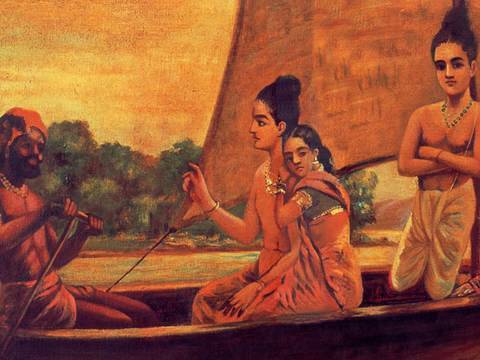Lord Rama is seen carrying His bow and arrow at all times and that symbolises His preparedness and strength to maintain peace and justice both within and without… He is the ideal of ‘aggressive goodness’…. He would not passively accept anything that is inconsistent with or contrary to morality and righteousness. – Swami Chinmayananda
Lord Vishnu, took his seventh avatar as Lord Rama. Ramayana revolves around Lord Rama’s incarnation and his greatness. Lord Rama is one of the most important avatars of Lord Vishnu born in Treta Yuga. Lord Rama was the eldest son of Dasharatha and Kaushalya; he was known as Maryada Purushottam Lord Rama, i.e. the Lord of Virtue.
Rama – a Perfect Character in the Ramayana
The great sage Valmiki has in his creation of this divine hero, symbolized in Him the ideal of uncompromising goodness. Nowhere else does one find such idealistic perfection in all walks of life, combined in a single individual. Thus, Rama was a perfect son, ideal king, a true husband, a real friend, a devoted brother, a noble enemy and so on.

Why the Criticisms?
While attempting to paint an ideal picture of each aspect of the Lord’s personality, the sage would not compromise with the standards of perfection conceived by him. He highlights one aspect of the personality at the expense of the others, so Rama’s conduct and behaviour, in certain instances appear to be inconsistent with His divine character.

Leaving King Dasaratha to Die
One such criticism leveled against Rama for leaving His father, King Dasaratha, and going away to the jungle. Dasaratha was severely protesting and Rama Himself knew that His father would not survive the sorrow of his son’s self-exile. This criticism has no bearing when one bears in mind that Rama was only playing the part of an ideal son…The boundless love that King Dasaratha and Rama bore for each other is brought out exquisitely vivid and clear. In spite of all these, Rama would not compromise in the fulfillment of His duty as a son. His father had promised a boon to fulfill the demand of Kaikeyi, and the son’s responsibility was to see that his father’s promise was redeemed notwithstanding the series of obstacles that confronted him as the son of Dasaratha.

Exiling His Queen Sita
Another common doubt and dissatisfaction among the critics of Ramayana is about Rama’s action in exiling His queen Sita, to the forest in response to the irresponsible prattle of a washerman, questioning the purity of the queen. A real King, in those days, was one who was accepted by all his subjects. Hence, when Rama found even a single dissenting vote in the voice of the public, he made the most significant sacrifice in sending His queen away. This action of Rama, though would appear absurd by the modern standards, portrays the sanctity Rama attached to the accepted standards of the ideal kinghood of His days.

Shooting Vali from Behind a Tree
Above all, the most criticised portion of the entire Ramayana is the apparent cowardice of the great hero Rama in having hidden behind a tree and shot the monkey king Vali, while the latter was engaged in a fight with his brother Sugreeva. Here again, Rama was only demonstrating His ideal friendship with Sugreeva. He would go to the extreme limit and do anything to help a true friend.
Vali was immoral and vicious, while Sugreeva was moral and virtuous. The story goes that Vali had earned, through tapas (austerity), a boon by which half the strength of his enemy was transferred to him as soon as an enemy confronted him in a battle. Thus, Rama is described to have hidden behind a tree and shooting Vali from a distance.

Conclusion
Hence, it is important that we look at Rama’s character in its entirety and understand why He did what He did. Thus, the character of Rama paints the picture of a Man-of-Perfection. He stands for righteousness and opposes and destroys all that is unrighteous. He was also an ideal brother, a perfect and chivalrous enemy and so on – every aspect of His personality is idealized to absolute perfection.
Read about where to find inspiration.
Reference: Art of God Symbolism by Swami Chinmayananda
6 Comments Add yours